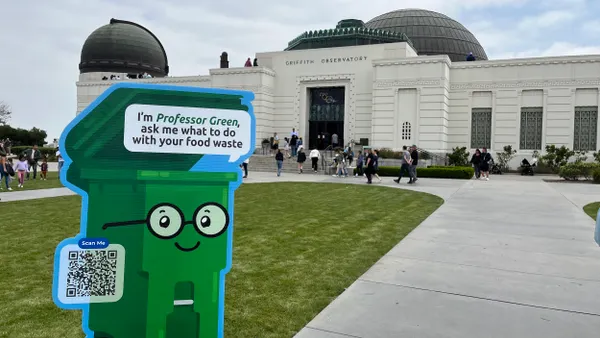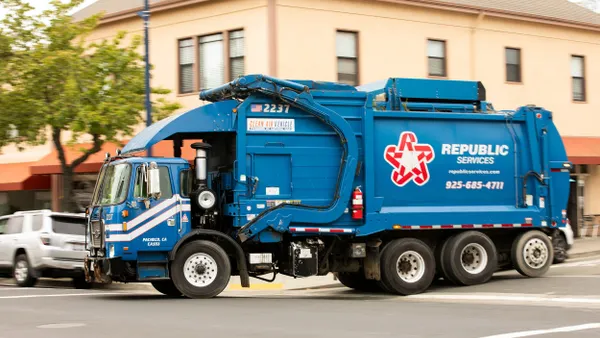Active landfills are a rare find in southern Maine. The nonprofit waste organization ecomaine has one of the last ones around — and uses it as little as possible.
The landfill is only a few miles away from downtown Portland, Maine’s largest city, and has been active for nearly 40 years. This likely would not have been feasible without ecomaine’s other waste management infrastructure, including a waste-to-energy (WTE) facility, built in 1988, and a material recovery facility (MRF) that opened in 1990. Today, the landfill handles residual ash, serves as a storage site and is a reminder of the nonprofit's mission.
"We have a very organized approach to managing solid waste," ecomaine CEO Kevin Roche told Waste Dive. "The fact that we still have an active landfill speaks volumes."
With 75 employees and operating revenues of $18.6 million during FY16, ecomaine may seem small in comparison to some of the industry’s larger operations. Yet at a time when major cities are paying to export their waste hundreds of miles away or fighting over odor issues, ecomaine has helped give southern Maine a local, collaborative option.
Founded in 1976 by four municipalities — and called Regional Waste Services at the time — the nonprofit’s mission is to provide sustainable, long-term waste management solutions. While it still needs to be fiscally responsible like any other organization, ecomaine does not rely on its landfill to drive revenues and has different criteria for how it operates.
The Portland-based operation now has 20 owner communities which guide its operations through representation on a board of directors. It currently serves more than 50 communities in the region and handles a quarter of Maine's residential waste.
Comparable statistics aren’t kept for all municipalities, but across ecomaine’s owner communities the average diversion rate is about 30%. Maine has a goal of reaching 50% diversion by 2021, and the nonprofit has been continually making adjustments to how it operates in an effort to help the state’s numbers move toward that goal.
Recycling
One big adjustment that ecomaine made back in 2007 was to switch its MRF to a single-stream operation, making that operation the first and largest of its kind in the state. Since then, the facility has seen a significant increase in material and processed 41,000 tons during the most recent fiscal year. Though like any other operation, ecomaine hasn’t been immune to the drop in commodity prices. Its recycling revenue of $2.51 million in FY16 was down by almost 19% from the year before.
Unlike other waste entities, ecomaine has yet to drop any major material categories from its program, but balancing its mission with economic realities can be difficult.
"We never like to send a message of 'don’t recycle,'" said Lisa Wolff, ecomaine’s communications manager, during a recent tour. "We’re really confined by the technology that we have and the markets."
For example, ecomaine hasn’t been making any money on 3-7 plastics for some time and had been including plastic bags it received in the same bales. Recently the board decided to stop accepting the bags after ongoing issues with them getting caught in star screens and other equipment.
Otherwise, ecomaine accepts the standard list of materials that most single-stream programs do — even glass. While the organization does not make a profit on glass because local end markets are scarce, they have found other beneficial uses for it in the area. The processed glass is used as aggregate for road work on ecomaine properties and in member communities, as well as a new nature trail project in a local development. They have also given some to manufacturers for making countertops — including the ones in their bathrooms.
The facility’s overall contamination rate is about 7% — below the industry average — though it still sees many unwanted items come through the conveyor belts. In addition to the common sightings of Christmas tree lights in the winter and propane tanks in the summer, the employees have seen weapons and even a bear pelt. A random street sign once tore up an entire conveyor belt and lumber sparked a fire that left its mark in the form of a smoke-stained ceiling.
Waste-to-energy
Right next door, ecomaine’s WTE facility handles close to 180,000 tons of residential and commercial waste per year with two boilers that run around the clock.
Because the Portland area is a major tourist destination during the summer, ecomaine sees the highest volumes in July and keeps some waste at its nearby landfill to save for later. When volumes decrease heading into winter — February is the slowest month — they will bring the waste back. The facility will be receiving its first shipment of stored waste this week. Like the snow-soaked material coming in on a recent morning this aged waste also brings lots of moisture that will affect the facility’s steam production.
The facility’s storage bunker has the capacity to hold more than 4,000 tons and it's not uncommon for some waste to sit for days before it gets plucked up for a trip to one of the boilers. The usual squirrels and birds have been known to make their way into the bunker, as well as a kitten that was rescued by employees after it evaded capture for a few days. The cat now lives with an employee's family and is doing well.
Seven stories up, the control room has chairs for two claw operators, however there is usually only one running at a time. A new automated claw will be installed in spring 2017 that will help speed up operations as needed with only one operator.
Starting in 2018, the facility will be receiving new tonnage from four mid-coast municipalities that recently voted to enter into a five-year contract with ecomaine. They chose ecomaine over the new Fiberight project that has been the source of ongoing debate farther upstate.
About 15% of the resulting power is used to operate the WTE plant and the remainder is sold. Last year the facility produced 96,000 megawatt hours of electricity. As with all modern WTE facilities, controlling emissions is a high priority and ecomaine has gone a step further by earning an ISO 14001 certification.
This aspect of ecomaine’s business is one which the organization would like to see get more recognition as a form of renewable energy and a higher use on the EPA’s waste hierarchy. Roche believes that landfill gas capture operations shouldn’t be considered the same as combustion. Yet he recognizes that changing this system won’t be easy.
"The landfill business is huge and they’re very tough to compete with," he said.
Landfill and Organics
As part of its ongoing efforts to stay competitive, ecomaine is also looking into new ash recovery technology that it could use to extract value from what has already been sent to the landfill.
During a previous multi-year project, ecomaine recovered an estimated 38,000 tons of metals that were valued at more than $7 million. This project also increased the landfill's airspace and extended its lifespan. Roche is intrigued by new technology that can sort the ash for metals under three-eighths of an inch and said that ecomaine may be going back in for another mining project in the future. He has toured similar operations in Washington state, York County, PA and Lancaster County, PA to learn more.
Another more immediate area of growth is ecomaine's new organics program. Based on a waste characterization study that found organics comprise more than 40% of the local waste stream and ongoing market growth in New England, this was an area that ecomaine had wanted to get into for years. After much research ecomaine landed on a partnership with Exeter Agri-Energy farther north. The company runs an anaerobic digester that co-digests food waste with animal waste.
"We wanted to make sure we had a partner who had the resources to do it right," said Roche.
Right now the program is in its early stages, driven by commercial customers and a discounted tipping fee. The material occupies a small section of ecomaine’s WTE tipping floor and is collected about once every two days for the trip upstate. Though next year two local municipalities will be starting pilot programs and others are in talks to join, which should help ecomaine's landfill last even longer.











